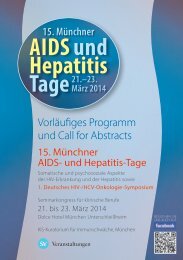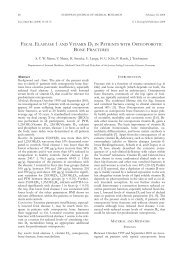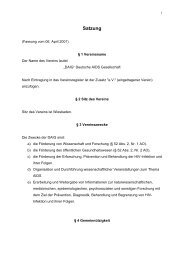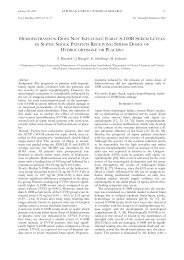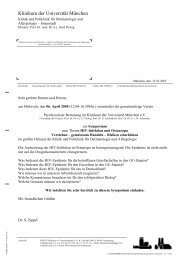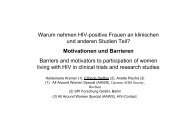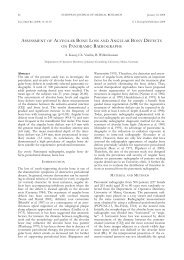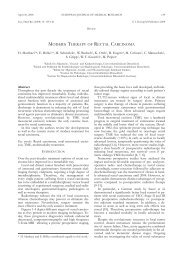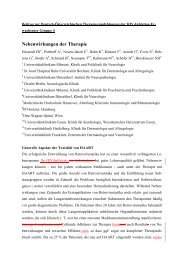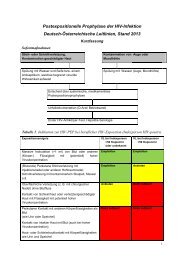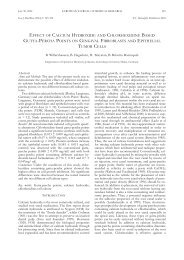European Journal of Medical Research - Deutsche AIDS ...
European Journal of Medical Research - Deutsche AIDS ...
European Journal of Medical Research - Deutsche AIDS ...
You also want an ePaper? Increase the reach of your titles
YUMPU automatically turns print PDFs into web optimized ePapers that Google loves.
54 EUROPEAN JOURNAL OF MEDICAL RESEARCH<br />
June 27, 2007<br />
28 pts (82%) HAART was given prior to HD and 6/26 pts<br />
(23%) had a prior <strong>AIDS</strong> defining illness. The median CD4<br />
counts at HD diagnosis was 300/�l.. Pts received/are receiving<br />
ABVD (n=11), BEACOPP baseline-21 (n=18) or BEA-<br />
COPP-14 (n=1). Grade 3/4 peripheral neuropathy and grade<br />
3/4 infections occurred in 6 <strong>of</strong> 21 pts each. To date response<br />
data are available in 15 pts (CR in 10 pts, PR in 4, SD in 1). 3<br />
pts have died, all <strong>of</strong> them diagnosed with stage IVB HD.<br />
Causes <strong>of</strong> death were treatment related sepsis during the 1st<br />
course <strong>of</strong> CT (n=1), progressive HD (n=1) and both, progressive<br />
HD and HIV-infection (n=1).<br />
Conclusions: In pts with HIV-HD risk-adapted CT and concomitant<br />
HAART is safe and effective. However, hematological<br />
toxicity is considerable. These preliminary data suggest<br />
that the prognosis <strong>of</strong> HIV-HD might approach results<br />
achieved in the HIV-negative population with HD.<br />
B.6 (Vortrag)<br />
Current trends in <strong>AIDS</strong>-Related Lymphoma<br />
(ARL) – preliminary results <strong>of</strong> the German ARL<br />
Cohort Study<br />
H<strong>of</strong>fmann C. 1 , Wyen C. 2 , Mayr C. 3 , Plettenberg A. 1 ,<br />
Oette M. 4 , van Lunzen J. 5 , Rockstroh J. 6 , Esser S. 7 ,<br />
Jäger H. 8 , Horst H.-A. 9 , Hentrich M. 10 , Mosthaf F. 11 ,<br />
Greiffendorf I. 12 , Hammond A. 13 , Fätkenheuer G. 2 , German<br />
ARL Cohort Study Group<br />
1 ifi Institut, Hamburg, Germany, 2 Universität Köln, Köln,<br />
Germany, 3 Ärzteforum Seestrasse, Berlin, Germany,<br />
4 Universität Düsseldorf, Düsseldorf, Germany,<br />
5 Universitätsklinikum Eppendorf, Hamburg, Germany,<br />
6 Universität Bonn, Bonn, Germany, 7 Universität Essen, Essen,<br />
Germany, 8 Muc<strong>Research</strong> GmbH, München, Germany,<br />
9 Universitätsklinikum Schleswig-Holstein, Kiel, Germany,<br />
10 Klinikum Harlaching, München, Germany,<br />
11 Schwerpunktpraxis, Karlsruhe, Germany, 12 Klinikum<br />
Krefeld, Krefeld, Germany, 13 Klinikum Augsburg, Augsburg,<br />
Germany<br />
Background: The incidence <strong>of</strong> ARL has decreased less pr<strong>of</strong>oundly<br />
than that <strong>of</strong> other <strong>AIDS</strong>-defining illnesses.<br />
Chemotherapy is hampered by toxicity and infectious complications.<br />
The German ARL Cohort Study was initiated in order<br />
to analyze the characteristics and outcome <strong>of</strong> patients (pts.)<br />
with ARL with respect to potential risk factors and to the use<br />
<strong>of</strong> specific polychemotherapy (PCT) and antiretroviral therapy<br />
(ART).<br />
Methods: This prospective multicenter cohort study includes<br />
pts with new or recurrent ARL (including Hodgkin’s Disease,<br />
HD) diagnosed since January 2005. After enrolment, pts are<br />
followed every six months.<br />
Results: As <strong>of</strong> January 2007, 103 patients (93 males, 10 females)<br />
from 16 centers were included in the cohort. The most<br />
common histological diagnosis was diffuse large B-cell lymphoma<br />
(40 %), followed by Burkitt lymphoma (19 %) and HD<br />
(15 %). Mean age at ARL diagnosis was 44.5 years (range,<br />
23.0–72.5). Median CD4 count was 211 cells/ul and 35 % <strong>of</strong><br />
the patients had a prior <strong>AIDS</strong>-defining illness. In 30 %, HIV<br />
was diagnosed at the time <strong>of</strong> ARL diagnosis. Only 51 % were<br />
treated with HAART, and 22 % had a plasma viremia below<br />
50 copies/ml. There were more HD cases in virologically suppressed<br />
pts. than in pts with detectable viremia (30 % vs 10<br />
%, p=0.03). Sixty-two pts (60 %) received a CHOP-based<br />
PCT while 11 pts (11 %) received a protocol <strong>of</strong> short and intensified<br />
PCT which was adapted from the German multicen-<br />
ter study group for adult acute lymphoblastic leukemia. The<br />
remaining 30 pts received other or no PCT. In 41 %, immunotherapy<br />
with rituximab was added to PCT. Of the 48 pts<br />
with available staging after completion <strong>of</strong> PCT, 29 (60 %) pts<br />
achieved complete remission <strong>of</strong> ARL. After a median followup<br />
<strong>of</strong> 5.9 months, 27 pts had died, among them 13 from progressive<br />
lymphoma. There were 6 treatment-related deaths<br />
(bloodstream infections) which were not related to specific<br />
PCT regimens.<br />
Conclusions: Preliminary data <strong>of</strong> this ongoing, prospective<br />
study suggest that many <strong>of</strong> ARL pts. do not receive ART at<br />
the time <strong>of</strong> diagnosis. HD seems to be more frequent in patients<br />
on ART. The high mortality and the relatively low rates<br />
<strong>of</strong> complete remission observed in this cohort underline the<br />
need for intensive efforts to improve treatment concepts <strong>of</strong> pts<br />
with ARL.<br />
B.7 (Vortrag)<br />
Second line chemotherapy with IMVP16 after<br />
failure <strong>of</strong> CHOP in patients with HIV-related<br />
Non-Hodgkin-Lymphomas<br />
Müller M. 1 , Kölsche F. 1 , Marretta L. 1 , Träder C. 1 ,<br />
Weiss R. 2 , Zwingers T. 3 , Kowol S. 1 , Arasteh K. 1<br />
1 Vivantes Auguste-Viktoria-Klinikum Berlin, Department <strong>of</strong><br />
Gastroenterology / Infectious Diseases, Berlin, Germany,<br />
2 Private Praxis, Bremen, Germany, 3 Estimate GmbH,<br />
Augsburg, Germany<br />
Objective: Since decades the CHOP regimen is a well established<br />
first line therapy for NHL. In former days HIV-patients<br />
with NHL had a poor prognosis. The introduction <strong>of</strong> HAART<br />
improved the overall survival. The impact <strong>of</strong> immunotherapy<br />
(Rituximab) in HIV-related NHL is under investigation. However,<br />
it is not clear as to how non-responders should be managed<br />
further.<br />
Method: Retrospective analysis <strong>of</strong> a single centre cohort <strong>of</strong><br />
140 HIV-patients with NHL, between 1/1989 and 10/2005.<br />
After failure <strong>of</strong> standard CHOP regimen (relapse or insufficient<br />
response) some patients received IMVP-16, a second<br />
line regimen, which is used in HIV-negative patients with<br />
lymphomas.<br />
Results: 29 patients with at least one cycle <strong>of</strong> IMVP-16 were<br />
identified with a median follow up <strong>of</strong> 26,2 months. Characteristics<br />
at NHL diagnosis: Median age: 41,9 years (range: 31-<br />
75years), median CD4: 180/�l, (range 20-560), HIV-stage<br />
(CDC) "C": 15 patients "B": 10 patients "A": 4 patients.<br />
NHL-stage (Ann-Arbor) I+II: 7 patients, III+IV: 22 patients.<br />
NHL-histology: DLBCL: 18 patients, Burkitt/Burkitt-like<br />
lymphomas: 5 patients, others: 6 patients. 2 patients were<br />
treated before 1997, 27 patients after 1997 (HAART era). 9<br />
patients are still alive with a median follow up <strong>of</strong> 52 months<br />
(range 35-92 months), 20 patients died after a median survival-time<br />
<strong>of</strong> 11 months (range 4-22 months).<br />
Conclusion: There is no standard second line chemotherapy<br />
in patients with relapsed or progressive HIV-related NHL´s.<br />
High dose chemotherapy and autologous stem-cell transplantation<br />
should be discussed in all patients. IMVP-16 might be a<br />
less invasive option.



